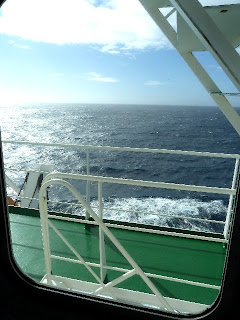I can see Canada. Well, I can see it in the top righthand corner of the chart on the navigation desk. In about three days, our great circle will bring Amber to the tip of Mexico's Baja Peninsula from where she'll continue southeast to the Panama Canal.

Amber rolls and rolls. High on the bridge, the waves aren't impressive, but from the main deck (where, for now, I'm advised not to walk) and with the human eye, it's rough. The problem for photos at sea is no perspective. Not even a seagull flying through a trough, so you can't judge the wave height.

People are sleeping badly, not just because of rolling, but nine time changes across the Pacific. Deck officers and lookouts are bleary eyed, since they have two, four-hour watches a day and, even normally, an eight-hour sleep is impossible.
Today we finally saw a ship, the Evergreen Diadem, heading west, our first encounter in eight days. It's a bad shot and only included as evidence.

Meeting a ship at sea was once a big deal:
"'Sail ho!' is a cry which always rouses interest on board, and a strong desire is felt to pass within hail of the strange ship, and exchange greetings. 'Speaking a ship at sea' is much resorted to, chiefly for purposes of giving and telling ships' names ... occasionally the longitude is asked, and not infrequently important news given. It is seldom that the vessels approach near enough to one another for the use of the speaking trumpet. The more usual method is by means of flags ..." (Orient Line Guide W. J. Loftie 1888)
Twenty-five years later, at the dawn of radio communication, another vessel in the middle of the ocean was still an event. Nowadays, electronic systems display the name of a ship and where bound, and there's usually no personal contact. That is, unless a bored sailor on Amber's bridge checks whether there's a Filipino in the wheelhouse of the other ship. If a Tagalog inquiry on the radio brings a response, there's exchange of ships' gossip and talk of home.
Second ship of the day, the MSC Maeva. The Pacific is vast, but another vessel, even in the distance, makes the immensity seem a little less impersonal.


